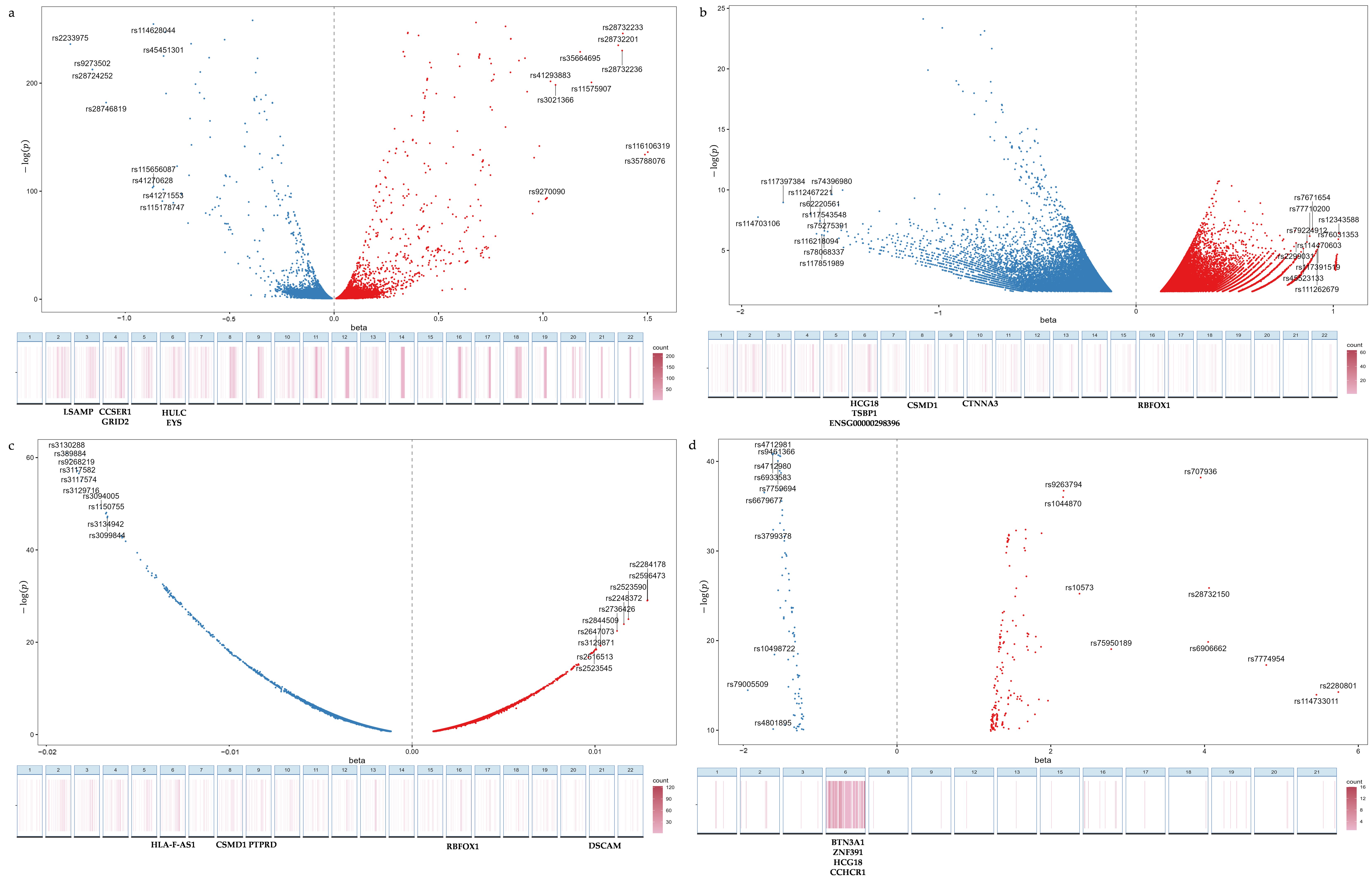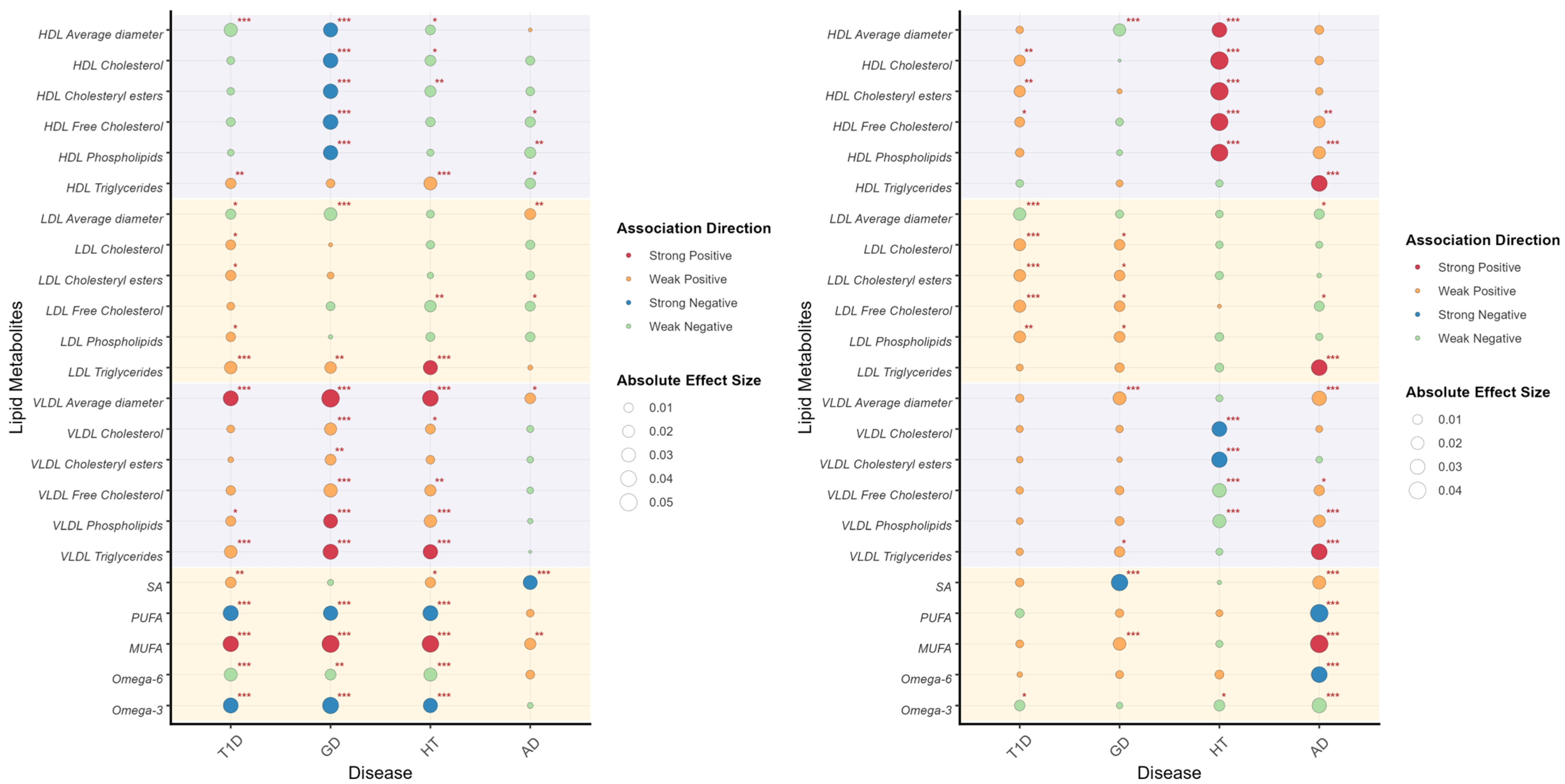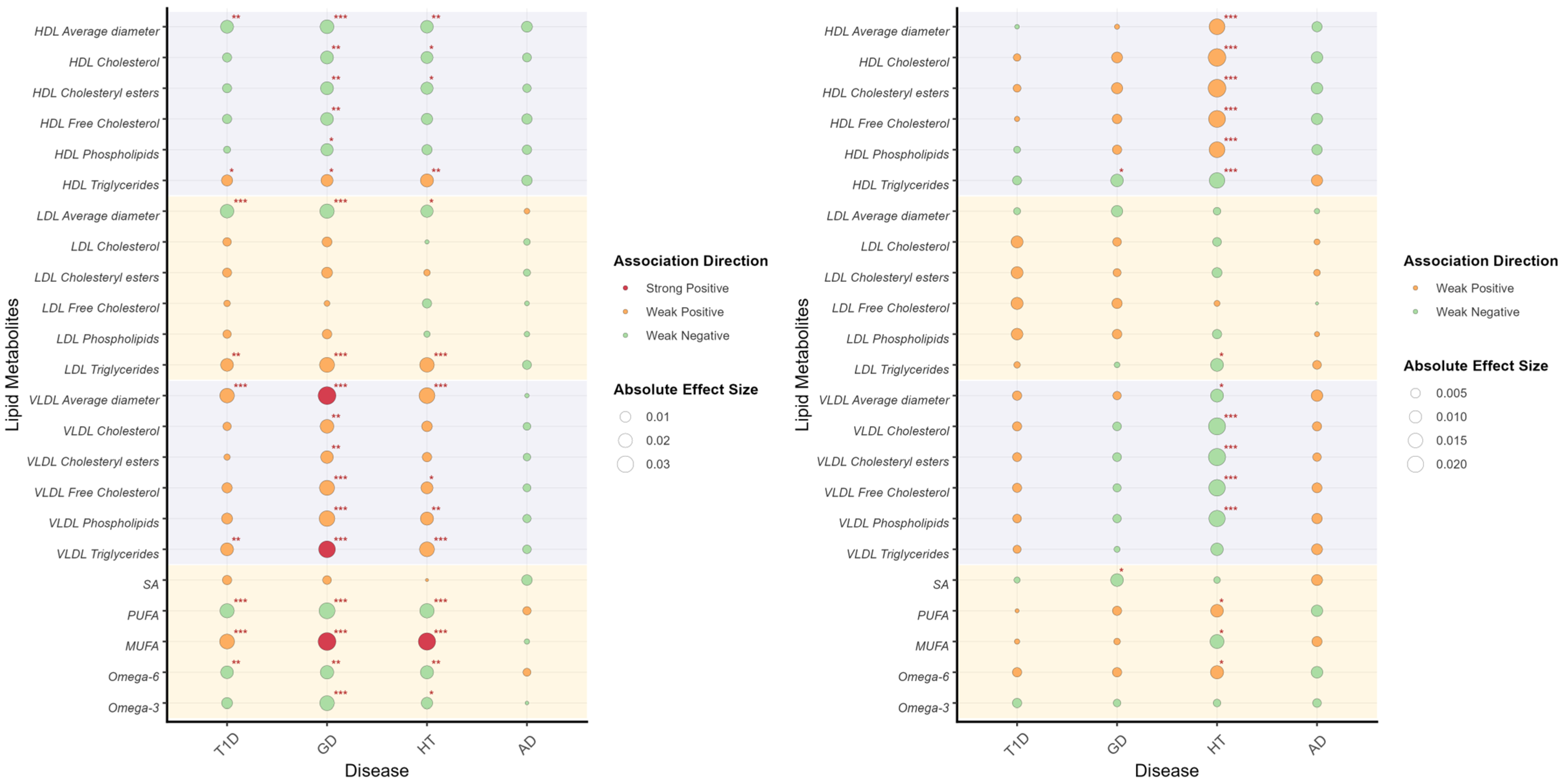Inflammation-Mediated Lipid Metabolism in Endocrine Autoimmune Diseases: A Genetic Distance-Based PRS Approach Integrating HLA Region
Abstract
1. Introduction
2. Materials and Methods
2.1. Study Population, Genetic and Phenotype Data
2.2. Data Quality Control and Imputation
2.3. Genetic Distance-Based Clumping for PRS
2.4. Statistical Analysis
2.5. Ethics Approval and Consent to Participate
3. Results
3.1. Baseline Characteristics of Participants
3.2. Distribution of Polygenic Risk Score and Model Performance
3.3. Common Genetic Architecture Across Traits
3.4. Polygenic Risk Score and Blood Lipid Metabolites
3.5. Mediation Effect of Immune and Inflammatory Biomarkers
3.6. Two Traits LDSC
4. Discussion
Supplementary Materials
Author Contributions
Funding
Institutional Review Board Statement
Informed Consent Statement
Data Availability Statement
Acknowledgments
Conflicts of Interest
Abbreviations
| T1D | Type1 diabetes |
| GD | Graves’ disease |
| AD | Addison’s disease |
| HT | Hashimoto’s thyroiditis |
| PRS | Polygenic risk score |
| HLA | Human leucocyte antigen |
| LD | Linkage disequilibrium |
| SNPs | Single-nucleotide polymorphisms |
| GWAS | Genome-wide association studies |
| MAF | Minor allele frequency |
| HWE | Hardy–Weinberg equilibrium |
| gPRS | Genetic distance-based clumping polygenic risk score |
| GLM | Generalized linear model |
| AUC | Area under the curve |
| KNN | K-nearest neighbors |
| HDL | High-density lipoprotein |
| VLDL | Very low-density lipoprotein |
| PUFAs | Polyunsaturated fatty acids |
| MUFAs | Monounsaturated fatty acids |
| lnRNA | Long non-coding RNA |
References
- Manso, J.; Pezzani, R.; Scarpa, R.; Gallo, N.; Betterle, C. The Natural History of Autoimmune Addison’s Disease with a Non-Classical Presentation: A Case Report and Review of Literature. Clin. Chem. Lab. Med. (CCLM) 2018, 56, 896–900. [Google Scholar] [CrossRef]
- Lan, N.S.R.; Bell, D.A.; Watts, G.F.; Fegan, P.G. Lipid-Lowering Therapies and Cardiovascular Risk-Stratification Strategies in Adults with Type 1 Diabetes. Curr. Opin. Endocrinol. Diabetes Obes. 2023, 30, 103. [Google Scholar] [CrossRef]
- Lanzolla, G.; Comi, S.; Cosentino, G.; Pakdel, F.; Marinò, M. Statins in Graves Orbitopathy: A New Therapeutic Tool. Ophthal. Plast. Reconstr. Surg. 2023, 39, S29. [Google Scholar] [CrossRef]
- Tagami, T.; Tamanaha, T.; Shimazu, S.; Honda, K.; Nanba, K.; Nomura, H.; Yoriko, S.U.; Usui, T.; Shimatsu, A.; Naruse, M. Lipid Profiles in the Untreated Patients with Hashimoto Thyroiditis and the Effects of Thyroxine Treatment on Subclinical Hypothyroidism with Hashimoto Thyroiditis. Endocr. J. 2010, 57, 253–258. [Google Scholar] [CrossRef] [PubMed]
- Mosca, A.M.; Barbosa, M.; Araújo, R.; Santos, M.J.; Mosca, A.; Barbosa, M.; Araújo, R.; Santos, M.J. Addison’s Disease: A Diagnosis Easy to Overlook. Cureus 2021, 13, e13364. [Google Scholar] [CrossRef] [PubMed]
- Ertunc, M.E.; Hotamisligil, G.S. Lipid Signaling and Lipotoxicity in Metaflammation: Indications for Metabolic Disease Pathogenesis and Treatment. J. Lipid Res. 2016, 57, 2099–2114. [Google Scholar] [CrossRef] [PubMed]
- Lim, S.A.; Su, W.; Chapman, N.M.; Chi, H. Lipid Metabolism in T Cell Signaling and Function. Nat. Chem. Biol. 2022, 18, 470–481. [Google Scholar] [CrossRef]
- Yu, W.; Lei, Q.; Yang, L.; Qin, G.; Liu, S.; Wang, D.; Ping, Y.; Zhang, Y. Contradictory Roles of Lipid Metabolism in Immune Response within the Tumor Microenvironment. J. Hematol. Oncol. 2021, 14, 187. [Google Scholar] [CrossRef]
- Nelson, A.J.; Stephenson, D.J.; Bone, R.N.; Cardona, C.L.; Park, M.A.; Tusing, Y.G.; Lei, X.; Kokotos, G.; Graves, C.L.; Mathews, C.E.; et al. Lipid Mediators and Biomarkers Associated with Type 1 Diabetes Development. JCI Insight 2020, 5, e138034. [Google Scholar] [CrossRef]
- Fisch, G.S. Associating Complex Traits with Genetic Variants: Polygenic Risk Scores, Pleiotropy and Endophenotypes. Genetica 2022, 150, 183–197. [Google Scholar] [CrossRef]
- Wray, N.R.; Lin, T.; Austin, J.; McGrath, J.J.; Hickie, I.B.; Murray, G.K.; Visscher, P.M. From Basic Science to Clinical Application of Polygenic Risk Scores: A Primer. JAMA Psychiatry 2021, 78, 101–109. [Google Scholar] [CrossRef]
- Wang, L.; Wang, F.-S.; Gershwin, M.E. Human Autoimmune Diseases: A Comprehensive Update. J. Intern. Med. 2015, 278, 369–395. [Google Scholar] [CrossRef]
- Marees, A.T.; de Kluiver, H.; Stringer, S.; Vorspan, F.; Curis, E.; Marie-Claire, C.; Derks, E.M. A Tutorial on Conducting Genome-Wide Association Studies: Quality Control and Statistical Analysis. Int. J. Methods Psychiatr. Res. 2018, 27, e1608. [Google Scholar] [CrossRef] [PubMed]
- Price, A.L.; Weale, M.E.; Patterson, N.; Myers, S.R.; Need, A.C.; Shianna, K.V.; Ge, D.; Rotter, J.I.; Torres, E.; Taylor, K.D.; et al. Long-Range LD Can Confound Genome Scans in Admixed Populations. Am. J. Hum. Genet. 2008, 83, 132–135. [Google Scholar] [CrossRef] [PubMed]
- Mastana, S.; Knight, E.; Hampson, A.; Akam, L.; Hunter, D.J.; Ghelani, A.; Samanta, A.; Singh, P. Role of Selected Genetic Polymorphisms in the Development of Rheumatoid Arthritis in a British White Population. Genes 2024, 15, 1009. [Google Scholar] [CrossRef] [PubMed]
- Ge, T.; Chen, C.-Y.; Ni, Y.; Feng, Y.-C.A.; Smoller, J.W. Polygenic Prediction via Bayesian Regression and Continuous Shrinkage Priors. Nat. Commun. 2019, 10, 1776. [Google Scholar] [CrossRef]
- Privé, F.; Arbel, J.; Vilhjálmsson, B.J. LDpred2: Better, Faster, Stronger. Bioinformatics 2021, 36, 5424–5431. [Google Scholar] [CrossRef]
- Hu, X.; Zhao, J.; Lin, Z.; Wang, Y.; Peng, H.; Zhao, H.; Wan, X.; Yang, C. Mendelian Randomization for Causal Inference Accounting for Pleiotropy and Sample Structure Using Genome-Wide Summary Statistics. Proc. Natl. Acad. Sci. USA 2022, 119, e2106858119. [Google Scholar] [CrossRef]
- Bulik-Sullivan, B.K.; Loh, P.-R.; Finucane, H.K.; Ripke, S.; Yang, J.; Patterson, N.; Daly, M.J.; Price, A.L.; Neale, B.M. LD Score Regression Distinguishes Confounding from Polygenicity in Genome-Wide Association Studies. Nat. Genet. 2015, 47, 291–295. [Google Scholar] [CrossRef]
- Claussnitzer, M.; Dankel, S.N.; Kim, K.-H.; Quon, G.; Meuleman, W.; Haugen, C.; Glunk, V.; Sousa, I.S.; Beaudry, J.L.; Puviindran, V.; et al. FTO Obesity Variant Circuitry and Adipocyte Browning in Humans. N. Engl. J. Med. 2015, 373, 895–907. [Google Scholar] [CrossRef]
- Pang, H.; Lin, J.; Luo, S.; Huang, G.; Li, X.; Xie, Z.; Zhou, Z. The Missing Heritability in Type 1 Diabetes. Diabetes Obes. Metab. 2022, 24, 1901–1911. [Google Scholar] [CrossRef] [PubMed]
- Tywanek, E.; Michalak, A.; Świrska, J.; Zwolak, A. Autoimmunity, New Potential Biomarkers and the Thyroid Gland—The Perspective of Hashimoto’s Thyroiditis and Its Treatment. Int. J. Mol. Sci. 2024, 25, 4703. [Google Scholar] [CrossRef]
- Koyama, S.; Yoshihara, N.; Takagi, A.; Komiyama, E.; Oka, A.; Ikeda, S. Clinical Findings, Response to Steroid Treatment, and Recurrence Rate in Alopecia Areata Patients with or without a Nonsynonymous Variant of Coiled-Coil Alpha-Helical Rod Protein 1. Ann. Dermatol. 2023, 35, 367–373. [Google Scholar] [CrossRef]
- Dönertaş, H.M.; Fabian, D.K.; Fuentealba, M.; Partridge, L.; Thornton, J.M. Common Genetic Associations between Age-Related Diseases. Nat. Aging 2021, 1, 400–412. [Google Scholar] [CrossRef]
- Zhou, J.; Zhang, J.; Tao, L.; Peng, K.; Zhang, Q.; Yan, K.; Luan, J.; Pan, J.; Su, X.; Sun, J.; et al. Up-Regulation of BTN3A1 on CD14+ Cells Promotes Vγ9Vδ2 T Cell Activation in Psoriasis. Proc. Natl. Acad. Sci. USA 2022, 119, e2117523119. [Google Scholar] [CrossRef] [PubMed]
- Yuan, L.; Ma, X.; Yang, Y.; Qu, Y.; Li, X.; Zhu, X.; Ma, W.; Duan, J.; Xue, J.; Yang, H.; et al. Phosphoantigens Glue Butyrophilin 3A1 and 2A1 to Activate Vγ9Vδ2 T Cells. Nature 2023, 621, 840–848. [Google Scholar] [CrossRef] [PubMed]
- Wang, Y.; Ji, N.; Zhang, Y.; Chu, J.; Pan, C.; Zhang, P.; Ma, W.; Zhang, X.; Xi, J.J.; Chen, M.; et al. B7H3-Targeting Chimeric Antigen Receptor Modification Enhances Antitumor Effect of Vγ9Vδ2 T Cells in Glioblastoma. J. Transl. Med. 2023, 21, 672. [Google Scholar] [CrossRef]
- Li, X.; Zhu, L.; Luo, Y. Long Non-Coding RNA HLA-F Antisense RNA 1 Inhibits the Maturation of microRNA-613 in Polycystic Ovary Syndrome to Promote Ovarian Granulosa Cell Proliferation and Inhibit Cell Apoptosis. Bioengineered 2022, 13, 12289–12297. [Google Scholar] [CrossRef]
- Zhang, C.-H.; Liu, X.-Y.; Wang, J. Essential Role of Granulosa Cell Glucose and Lipid Metabolism on Oocytes and the Potential Metabolic Imbalance in Polycystic Ovary Syndrome. Int. J. Mol. Sci. 2023, 24, 16247. [Google Scholar] [CrossRef]
- Pu, Y.; Zhao, H.; Wu, X.; Mei, M.; Shen, B. The Long Noncoding RNA Ptprd-IR Is a Novel Molecular Target for TGF-Β1-Mediated Nephritis. Int. J. Biochem. Cell Biol. 2020, 122, 105742. [Google Scholar] [CrossRef]
- Nagesh, P.T.; Nishi, H.; Rawal, S.; Zahr, T.; Miano, J.M.; Sorci-Thomas, M.; Xu, H.; Akbar, N.; Choudhury, R.P.; Misra, A.; et al. HDL Regulates TGFß-Receptor Lipid Raft Partitioning, Restoring Contractile Features of Cholesterol-Loaded Vascular Smooth Muscle Cells. bioRxiv 2023, arXiv:bioRxiv:2023.10.19.562786. [Google Scholar] [CrossRef]
- Chen, Z.-L.; Chen, Y.-X.; Zhou, J.; Li, Y.; Gong, C.-Y.; Wang, X.-B. LncRNA HULC Alleviates HUVEC Inflammation and Improves Angiogenesis after Myocardial Infarction through Down-Regulating miR-29b. Eur. Rev. Med. Pharmacol. Sci. 2020, 24, 6288–6298. [Google Scholar] [CrossRef] [PubMed]
- Yu, X.; Zheng, H.; Chan, M.T.V.; Wu, W.K.K. HULC: An Oncogenic Long Non-Coding RNA in Human Cancer. J. Cell Mol. Med. 2017, 21, 410–417. [Google Scholar] [CrossRef]
- Yi, L.; Song, C.; Liu, Y.; Li, D.; Xiao, T.; Guo, X.; Wu, Y. Down-Regulation of Long Noncoding RNA HULC Inhibits the Inflammatory Response in Ankylosing Spondylitis by Reducing miR-556-5p-Mediated YAP1 Expression. J. Orthop. Surg. Res. 2023, 18, 551. [Google Scholar] [CrossRef]
- Zhao, J.; Quan, J.; Chen, W.; Xie, X. Grid2 Interacting Protein Is a Potential Biomarker Related to Immune Infiltration in Colorectal Cancer. Eur. J. Med. Res. 2023, 28, 511. [Google Scholar] [CrossRef]
- Comparative Genetic Architectures of Schizophrenia in East Asian and European Populations.—Abstract—Europe PMC. Available online: https://europepmc.org/article/med/31740837 (accessed on 17 January 2025).
- Panyard, D.J.; Kim, K.M.; Darst, B.F.; Deming, Y.K.; Zhong, X.; Wu, Y.; Kang, H.; Carlsson, C.M.; Johnson, S.C.; Asthana, S.; et al. Cerebrospinal Fluid Metabolomics Identifies 19 Brain-Related Phenotype Associations. Commun. Biol. 2021, 4, 63. [Google Scholar] [CrossRef] [PubMed]
- Tuysuz, E.C.; Mourati, E.; Rosberg, R.; Moskal, A.; Gialeli, C.; Johansson, E.; Governa, V.; Belting, M.; Pietras, A.; Blom, A.M. Tumor Suppressor Role of the Complement Inhibitor CSMD1 and Its Role in TNF-Induced Neuroinflammation in Gliomas. J. Exp. Clin. Cancer Res. 2024, 43, 98. [Google Scholar] [CrossRef]
- Zhang, L.; Wang, Z.; Li, M.; Sun, P.; Bai, T.; Wang, W.; Bai, H.; Gou, J.; Wang, Z. HCG18 Participates in Vascular Invasion of Hepatocellular Carcinoma by Regulating Macrophages and Tumor Stem Cells. Front. Cell Dev. Biol. 2021, 9, 707073. [Google Scholar] [CrossRef]
- Xia, Y.; Zhang, Y.; Wang, H. Upregulated lncRNA HCG18 in Patients with Non-Alcoholic Fatty Liver Disease and Its Regulatory Effect on Insulin Resistance. Diabetes Metab. Syndr. Obes. 2021, 14, 4747–4756. [Google Scholar] [CrossRef]
- Noble, J.A. Fifty Years of HLA-Associated Type 1 Diabetes Risk: History, Current Knowledge, and Future Directions. Front. Immunol. 2024, 15, 1457213. [Google Scholar] [CrossRef]
- Stasiak, M.; Zawadzka-Starczewska, K.; Tymoniuk, B.; Stasiak, B.; Lewiński, A. Associations between Lipid Profiles and Graves’ Orbitopathy Can Be HLA-Dependent. Genes 2023, 14, 1209. [Google Scholar] [CrossRef]
- Chiorean, A.-D.; Nicula, G.Z.; Bâlici, Ș.; Vică, M.L.; Iancu Loga, L.-I.; Dican, L.; Matei, H.V. HLA Class II Allele Groups Involved in Autoimmune Thyroid Diseases: Hashimoto’s Thyroiditis and Basedow–Graves Disease. Life 2024, 14, 441. [Google Scholar] [CrossRef]
- Altshuler, D.; Daly, M.J.; Lander, E.S. Genetic Mapping in Human Disease. Science 2008, 322, 881–888. [Google Scholar] [CrossRef]
- Mountjoy, E.; Schmidt, E.M.; Carmona, M.; Schwartzentruber, J.; Peat, G.; Miranda, A.; Fumis, L.; Hayhurst, J.; Buniello, A.; Karim, M.A.; et al. An Open Approach to Systematically Prioritize Causal Variants and Genes at All Published Human GWAS Trait-Associated Loci. Nat. Genet. 2021, 53, 1527–1533. [Google Scholar] [CrossRef] [PubMed]
- Soppert, J.; Lehrke, M.; Marx, N.; Jankowski, J.; Noels, H. Lipoproteins and Lipids in Cardiovascular Disease: From Mechanistic Insights to Therapeutic Targeting. Adv. Drug Deliv. Rev. 2020, 159, 4–33. [Google Scholar] [CrossRef] [PubMed]
- Yang, H.S.; Jeong, H.J.; Kim, H.; Lee, S.; Hur, M. Sex-Specific Relationships between HDL-Cholesterol Levels and 10-Year Mortality in Individuals with Atherosclerotic Cardiovascular Disease: A Nationwide Cohort Study of South Koreans. Metabolites 2023, 13, 1175. [Google Scholar] [CrossRef] [PubMed]
- Chen, D.; Ueda, R.; Harding, F.; Patil, N.; Mao, Y.; Kurahara, C.; Platenburg, G.; Huang, M. Characterization of HLA DR3/DQ2 Transgenic Mice: A Potential Humanized Animal Model for Autoimmune Disease Studies. Eur. J. Immunol. 2003, 33, 172–182. [Google Scholar] [CrossRef]
- Pereira Vasconcelos, A.; Santos e Silva, J.C.; Simizo, A.; Peña Avila, J.; Nassar Reich Goldstein, G.; Prado de Oliveira, P.H.; Mogollón García, H.; de Carvalho Fraga, C.A.; Nakaya, H.I. Sex-Based Differences in Thyroid Plasma B Cell Infiltration: Implications for Autoimmune Disease Susceptibility. Endocrinology 2024, 165, bqae148. [Google Scholar] [CrossRef]
- Elías-López, D.; Doi, T.; Nordestgaard, B.G.; Kobylecki, C.J. Remnant Cholesterol and Low-Grade Inflammation Jointly in Atherosclerotic Cardiovascular Disease: Implications for Clinical Trials. Curr. Opin. Clin. Nutr. Metab. Care 2024, 27, 125. [Google Scholar] [CrossRef]
- Prasun, P. Mitochondrial Dysfunction in Metabolic Syndrome. Biochim. Biophys. Acta (BBA)-Mol. Basis Dis. 2020, 1866, 165838. [Google Scholar] [CrossRef]
- Wu, Y.; Huang, M.; Chen, X.; Wu, J.; Li, L.; Wei, J.; Lu, C.; Han, L.; Lu, Y. A Genome-Wide Cross-Trait Analysis Identifies Shared Loci and Causal Relationships of Obesity and Lipidemic Traits with Psoriasis. Front. Immunol. 2024, 15, 1328297. [Google Scholar] [CrossRef] [PubMed]
- Palmisano, B.T.; Zhu, L.; Eckel, R.H.; Stafford, J.M. Sex Differences in Lipid and Lipoprotein Metabolism. Mol. Metab. 2018, 15, 45–55. [Google Scholar] [CrossRef]
- Coniglio, S.; Shumskaya, M.; Vassiliou, E. Unsaturated Fatty Acids and Their Immunomodulatory Properties. Biology 2023, 12, 279. [Google Scholar] [CrossRef]
- Ravaut, G.; Légiot, A.; Bergeron, K.-F.; Mounier, C. Monounsaturated Fatty Acids in Obesity-Related Inflammation. Int. J. Mol. Sci. 2021, 22, 330. [Google Scholar] [CrossRef] [PubMed]
- Mika, A.; Sikorska-Wiśniewska, M.; Małgorzewicz, S.; Stepnowski, P.; Dębska-Ślizień, A.; Śledziński, T.; Chmielewski, M. Potential Contribution of Monounsaturated Fatty Acids to Cardiovascular Risk in Chronic Kidney Disease. Pol. Arch. Intern. Med. 2018, 128, 755–763. [Google Scholar] [CrossRef] [PubMed]




| T1D | GD | HT | AD | Control | |
|---|---|---|---|---|---|
| age | 58.586 (7.671) | 56.323 (7.971) | 56.906 (7.825) | 57.442 (8.032) | 56.363 (8.049) |
| sex | |||||
| males | 2475 (58.3%) | 180 (19.9%) | 29 (7.6%) | 141 (40.4%) | 16,959 (46.9%) |
| females | 1770 (41.6%) | 727 (80.1%) | 348 (92.3%) | 208 (59.5%) | 19,134 (53.0%) |
| total | 4245 | 907 | 377 | 349 | 36,093 |
| gPRS | gPRS_nHLA | C + T | PRS-CS | |
|---|---|---|---|---|
| T1D | 0.724 | 0.717 | 0.578 | 0.618 |
| GD | 0.758 | 0.709 | 0.687 | 0.766 |
| HT | 0.856 | 0.801 | 0.741 | 0.805 |
| AD | 0.564 | 0.555 | 0.608 | 0.583 |
| T1D | GD | HT | ||||
|---|---|---|---|---|---|---|
| Genetic Correlation | p | Genetic Correlation | p | Genetic Correlation | p | |
| HDL Cholesterol | −0.065 (0.050) | 0.195 | −0.055 (0.038) | 0.155 | −0.091 (0.038) | 0.017 |
| Cholesteryl esters in HDL | 0.110 (0.120) | 0.360 | 0.123 (0.091) | 0.175 | 0.056 (0.093) | 0.552 |
| Free cholesterol in HDL | −0.132 (0.067) | 0.048 | −0.032 (0.056) | 0.571 | −0.252 (0.064) | <0.001 |
| Cholesteryl esters in VLDL | 0.030 (0.062) | 0.630 | 0.125 (0.052) | 0.017 | 0.265 (0.059) | <0.001 |
| Average Diameter of VLDL | −0.039 (0.064) | 0.542 | 0.052 (0.061) | 0.396 | 0.203 (0.062) | 0.001 |
| Omega3 Fatty Acids | −0.075 (0.048) | 0.113 | −0.028 (0.043) | 0.518 | 0.029 (0.039) | 0.456 |
| PUFAs | −0.023 (0.067) | 0.728 | −0.078 (0.062) | 0.208 | −0.285 (0.061) | <0.001 |
| MUFAs | 0.024 (0.064) | 0.703 | 0.073 (0.059) | 0.218 | 0.306 (0.061) | <0.001 |
Disclaimer/Publisher’s Note: The statements, opinions and data contained in all publications are solely those of the individual author(s) and contributor(s) and not of MDPI and/or the editor(s). MDPI and/or the editor(s) disclaim responsibility for any injury to people or property resulting from any ideas, methods, instructions or products referred to in the content. |
© 2025 by the authors. Licensee MDPI, Basel, Switzerland. This article is an open access article distributed under the terms and conditions of the Creative Commons Attribution (CC BY) license (https://creativecommons.org/licenses/by/4.0/).
Share and Cite
Liu, F.; Ren, Y.; Liu, W.; Chen, Q.; Yin, P.; Wang, P. Inflammation-Mediated Lipid Metabolism in Endocrine Autoimmune Diseases: A Genetic Distance-Based PRS Approach Integrating HLA Region. Genes 2025, 16, 1379. https://doi.org/10.3390/genes16111379
Liu F, Ren Y, Liu W, Chen Q, Yin P, Wang P. Inflammation-Mediated Lipid Metabolism in Endocrine Autoimmune Diseases: A Genetic Distance-Based PRS Approach Integrating HLA Region. Genes. 2025; 16(11):1379. https://doi.org/10.3390/genes16111379
Chicago/Turabian StyleLiu, Fenghuixue, Yifei Ren, Wenhua Liu, Qi Chen, Ping Yin, and Peng Wang. 2025. "Inflammation-Mediated Lipid Metabolism in Endocrine Autoimmune Diseases: A Genetic Distance-Based PRS Approach Integrating HLA Region" Genes 16, no. 11: 1379. https://doi.org/10.3390/genes16111379
APA StyleLiu, F., Ren, Y., Liu, W., Chen, Q., Yin, P., & Wang, P. (2025). Inflammation-Mediated Lipid Metabolism in Endocrine Autoimmune Diseases: A Genetic Distance-Based PRS Approach Integrating HLA Region. Genes, 16(11), 1379. https://doi.org/10.3390/genes16111379







